Meet the Author Meet Elizabeth Kollmarrubber band crafter, author, and eleven year old! Elizabeth has always been super crafty and full of ideas. Her creative thinking led to the design of the twelve motifs and countless variations youll find in this book. Find out more about Elizabeth and the things she lovesWhat kind of crafts do you like? My family is very creative and we love fiber arts. I learned the basics of knitting and crochet when I was very little by doing lots of projects with my family. I even designed my own knitting piece when I was six! How did you start working with rubber bands? My mom works at a craft store, so we knew when rubber bands were getting to be a big thing. So many other kids my age were using rubber band looms to make cool projects.
Meet Elizabeth Kollmarrubber band crafter, author, and eleven year old! Elizabeth has always been super crafty and full of ideas. Her creative thinking led to the design of the twelve motifs and countless variations youll find in this book. Find out more about Elizabeth and the things she lovesWhat kind of crafts do you like? My family is very creative and we love fiber arts. I learned the basics of knitting and crochet when I was very little by doing lots of projects with my family. I even designed my own knitting piece when I was six! How did you start working with rubber bands? My mom works at a craft store, so we knew when rubber bands were getting to be a big thing. So many other kids my age were using rubber band looms to make cool projects.
I wanted to try it out to see what I could do. Why do you use a hook? My mom bought my brother, sister, and me a rubber band loom before we left for vacation. We wouldnt be able to use the Internet while we were away, so we wrote down a few instructions for the loom before we left. I just couldnt get them to work for me, so I started playing with the hook that came with the loom. Because I knew a little bit about crochet, it seemed natural for me to loop the bands on the hook. The only problem was I had to take the bands off the hook to turn them around and work on the other side.
Getting the bands on and off the hook was really tricky, but then my mom suggested I use a double-ended crochet hook so I wouldnt have to take them off at all. It was perfect! What other hobbies do you have? I love photography. Ive competed in some junior competitions and won a few first place awards! I also like reading and music. I play the piano and the harp. What do you do when youre not crafting? I love outdoor activities like horseback riding, bicycling, swimming, and archery. My family has lots of small pets that I help take care of.
My favorite is my Dutch bunny named Emily. I also spend lots of time having fun with my parents and older brother and younger sister. We love doing special things together. What do you want to do when you grow up? My dream job is one where I can care for or train animals! Where can I find out more about you and your work? Visit me at elizabethkollmar.com to learn about my current projects and activities. 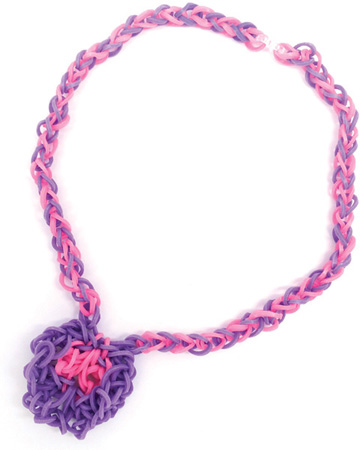
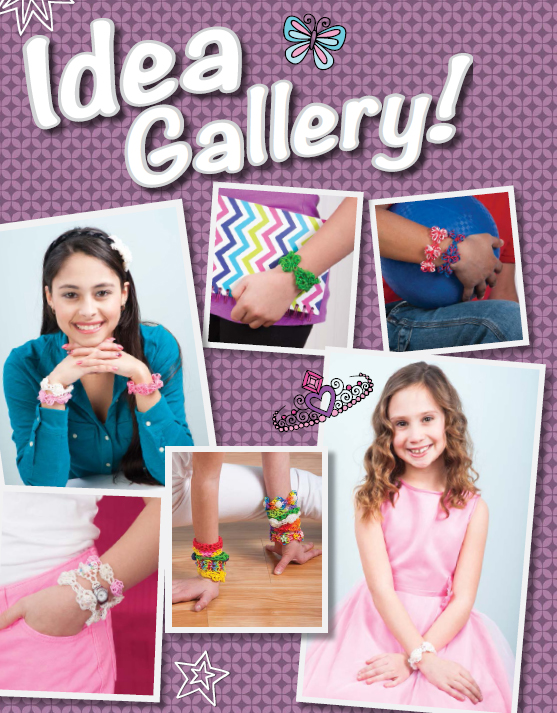
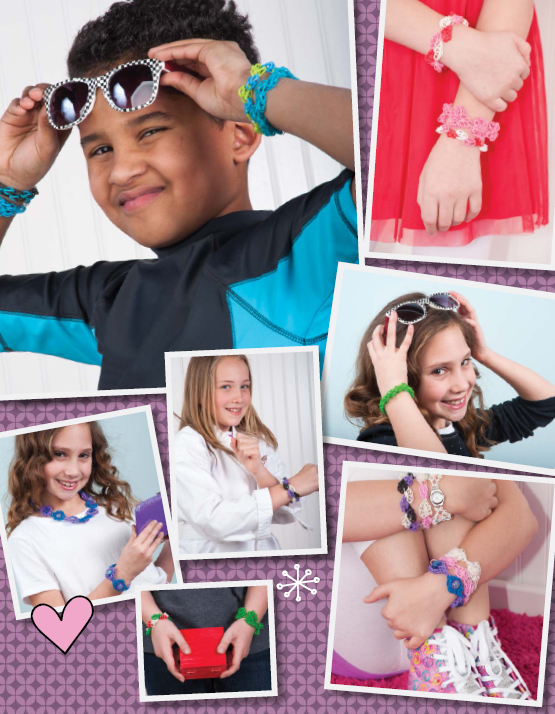 How to Use This Book This book uses a very unique method of banding, but dont worryits easy! Here, youll find everything you need to know to achieve success! The instructions and diagrams will show you how to make different design motifs that you can repeat to craft things like bracelets and necklaces. All of the motifs contain the same elements so you can follow along easily:
How to Use This Book This book uses a very unique method of banding, but dont worryits easy! Here, youll find everything you need to know to achieve success! The instructions and diagrams will show you how to make different design motifs that you can repeat to craft things like bracelets and necklaces. All of the motifs contain the same elements so you can follow along easily:
- Difficulty level
- Gauge
- Materials list: What Do I Need?
- Instructions: Breaking the Code!
- Diagrams

Difficulty Level This is just a guide to let you know how complicated a project is before you get started.
If youre new to banding, try starting with a beginner motif and move up to intermediate and advanced motifs as you gain skills and confidence. Gauge The gauge tells you how long a motif is when it is not being stretched. You can use the gauge (plus a tape measure and calculator) to figure out how many times you need to repeat a motif to make a project the length you want. Once you figure out the number of motifs you need to make, you can figure out how many bands you need for your project. Figuring out the number of bands ahead of time means you wont have to run out to the store to get more while youre making your project! See the example on to figure out how to calculate the number of motifs and bands you need to make a project. What is a motif? A motif is a single design that can be repeated several times to create a piece of jewelry or other item.
Many motifs, like the one at the right, are built from the bottom up. 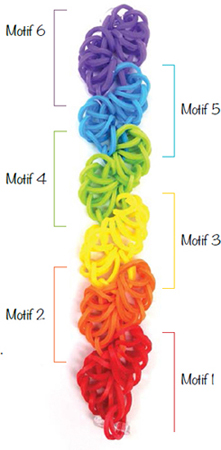 Sizing Example: Lets figure out how to use the gauge to plan your project. Say you want to make a bracelet. First, measure around your wrist to see how long the bracelet should be. Lets say your wrist measures 6" around. Subtract 1" from this measurement.
Sizing Example: Lets figure out how to use the gauge to plan your project. Say you want to make a bracelet. First, measure around your wrist to see how long the bracelet should be. Lets say your wrist measures 6" around. Subtract 1" from this measurement.
The result is the finished length you want your bracelet to be. Subtracting an inch will ensure your bracelet fits snugly because the bands will have to stretch just a bit to fit your wrist. 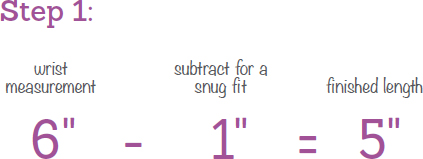 Youve calculated the finished length for your bracelet. Now its time to pick your motif. Say you want to make a bracelet using the . The Half Shell motif has a gauge of 1".
Youve calculated the finished length for your bracelet. Now its time to pick your motif. Say you want to make a bracelet using the . The Half Shell motif has a gauge of 1".
To figure out the number of motifs you need to make for your bracelet, divide the finished length for your bracelet by the gauge of the motif you want to use. You will need to repeat the motif 5 times to make your bracelet. 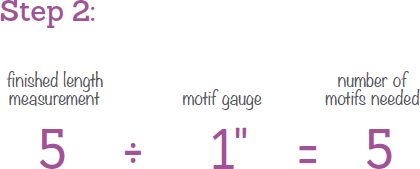 The materials list tells you that you need 10 bands to make 1 Half Shell motif. To figure out the number of bands you need for the entire bracelet, multiply the number of motifs you need to make by the number of bands you need for just one motif.
The materials list tells you that you need 10 bands to make 1 Half Shell motif. To figure out the number of bands you need for the entire bracelet, multiply the number of motifs you need to make by the number of bands you need for just one motif. 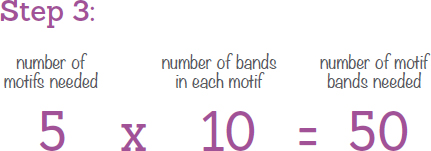 Each project uses foundation bands to get started. Dont forget to add these to the total number of bands for your project.
Each project uses foundation bands to get started. Dont forget to add these to the total number of bands for your project.
The Half Shell motif uses 2 foundation bands. Add this to the number of bands you calculated in Step 3 above.  Too Short? What if repeating a motif five times is not enough, but repeating it six times is too much? You can always add length to a project by attaching a before the first motif and/or after the last motif. What Do I Need? Before you get started, youll want to have these items on hand. They will be easy to find at your local craft or hobby store.
Too Short? What if repeating a motif five times is not enough, but repeating it six times is too much? You can always add length to a project by attaching a before the first motif and/or after the last motif. What Do I Need? Before you get started, youll want to have these items on hand. They will be easy to find at your local craft or hobby store. 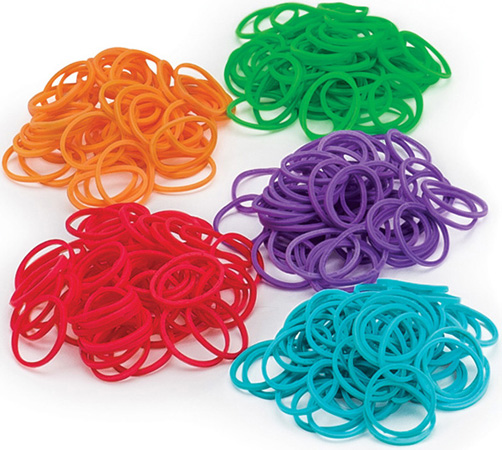 Rubber bands (3/4" [2cm] in diameter): The materials list for each motif lists the number of foundation bands you need to get started, plus the number of bands youll need to make one motif.
Rubber bands (3/4" [2cm] in diameter): The materials list for each motif lists the number of foundation bands you need to get started, plus the number of bands youll need to make one motif.
Follow the example on to use this info to figure out how many bands youll need to make your entire project. 
Next page

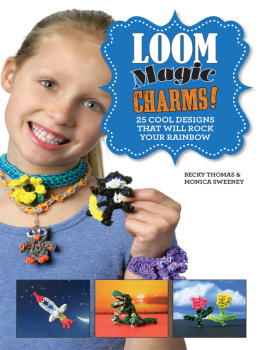
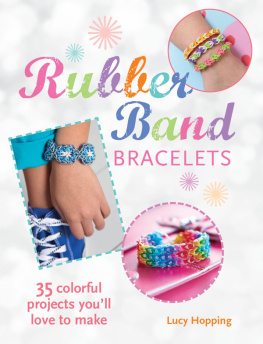

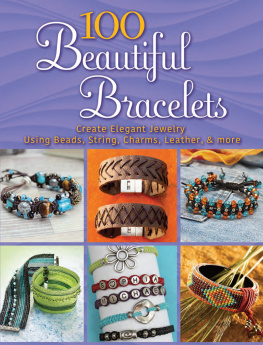

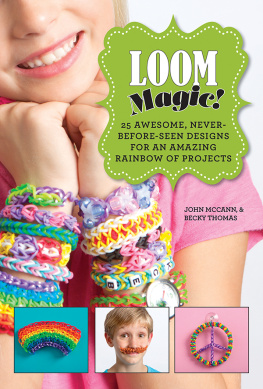
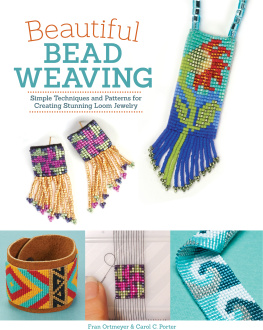
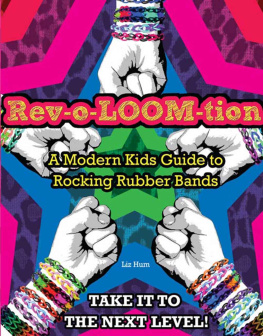
 Meet Elizabeth Kollmarrubber band crafter, author, and eleven year old! Elizabeth has always been super crafty and full of ideas. Her creative thinking led to the design of the twelve motifs and countless variations youll find in this book. Find out more about Elizabeth and the things she lovesWhat kind of crafts do you like? My family is very creative and we love fiber arts. I learned the basics of knitting and crochet when I was very little by doing lots of projects with my family. I even designed my own knitting piece when I was six! How did you start working with rubber bands? My mom works at a craft store, so we knew when rubber bands were getting to be a big thing. So many other kids my age were using rubber band looms to make cool projects.
Meet Elizabeth Kollmarrubber band crafter, author, and eleven year old! Elizabeth has always been super crafty and full of ideas. Her creative thinking led to the design of the twelve motifs and countless variations youll find in this book. Find out more about Elizabeth and the things she lovesWhat kind of crafts do you like? My family is very creative and we love fiber arts. I learned the basics of knitting and crochet when I was very little by doing lots of projects with my family. I even designed my own knitting piece when I was six! How did you start working with rubber bands? My mom works at a craft store, so we knew when rubber bands were getting to be a big thing. So many other kids my age were using rubber band looms to make cool projects.

 How to Use This Book This book uses a very unique method of banding, but dont worryits easy! Here, youll find everything you need to know to achieve success! The instructions and diagrams will show you how to make different design motifs that you can repeat to craft things like bracelets and necklaces. All of the motifs contain the same elements so you can follow along easily:
How to Use This Book This book uses a very unique method of banding, but dont worryits easy! Here, youll find everything you need to know to achieve success! The instructions and diagrams will show you how to make different design motifs that you can repeat to craft things like bracelets and necklaces. All of the motifs contain the same elements so you can follow along easily: Difficulty Level This is just a guide to let you know how complicated a project is before you get started.
Difficulty Level This is just a guide to let you know how complicated a project is before you get started.  Sizing Example: Lets figure out how to use the gauge to plan your project. Say you want to make a bracelet. First, measure around your wrist to see how long the bracelet should be. Lets say your wrist measures 6" around. Subtract 1" from this measurement.
Sizing Example: Lets figure out how to use the gauge to plan your project. Say you want to make a bracelet. First, measure around your wrist to see how long the bracelet should be. Lets say your wrist measures 6" around. Subtract 1" from this measurement. Youve calculated the finished length for your bracelet. Now its time to pick your motif. Say you want to make a bracelet using the . The Half Shell motif has a gauge of 1".
Youve calculated the finished length for your bracelet. Now its time to pick your motif. Say you want to make a bracelet using the . The Half Shell motif has a gauge of 1". The materials list tells you that you need 10 bands to make 1 Half Shell motif. To figure out the number of bands you need for the entire bracelet, multiply the number of motifs you need to make by the number of bands you need for just one motif.
The materials list tells you that you need 10 bands to make 1 Half Shell motif. To figure out the number of bands you need for the entire bracelet, multiply the number of motifs you need to make by the number of bands you need for just one motif.  Each project uses foundation bands to get started. Dont forget to add these to the total number of bands for your project.
Each project uses foundation bands to get started. Dont forget to add these to the total number of bands for your project. Too Short? What if repeating a motif five times is not enough, but repeating it six times is too much? You can always add length to a project by attaching a before the first motif and/or after the last motif. What Do I Need? Before you get started, youll want to have these items on hand. They will be easy to find at your local craft or hobby store.
Too Short? What if repeating a motif five times is not enough, but repeating it six times is too much? You can always add length to a project by attaching a before the first motif and/or after the last motif. What Do I Need? Before you get started, youll want to have these items on hand. They will be easy to find at your local craft or hobby store.  Rubber bands (3/4" [2cm] in diameter): The materials list for each motif lists the number of foundation bands you need to get started, plus the number of bands youll need to make one motif.
Rubber bands (3/4" [2cm] in diameter): The materials list for each motif lists the number of foundation bands you need to get started, plus the number of bands youll need to make one motif.